In 2006, the KAIST Institute for the NanoCentury (KINC) was established as a research institute affiliated with the KAIST Institute in order to intensify research related to nano science and technology sporadically conducted by various departments within KAIST, and to activate collaborative research as well. Collaborative/interdisciplinary research in the field of nano-science and nanotechnology is desperately needed as it requires different experts to maximize the research capacity and to adopt fast moving trends of nanotechnology. Accordingly, the Nano Convergence Research Institute aims to grow into a world-class research center leading the creation of new value and technological innovation by establishing an optimized collaborative research system and maximizing nano research results.
Currently, the Nano Convergence Research Institute is the largest convergence research institute in Korea, with more than 70 professors from 9 departments at KAIST, as well as a member of the top 10 internationally. The Nano Convergence Research Center consists of three research groups (climate change response nanotechnology, next-generation healthcare nanotechnology, next-generation information device nanotechnology) and three industry-academia-research centers (KCC-KAIST industry-academic cooperation research center, Hankook Tire-KAIST Future Tire Technology Research Center, Nano Advanced Institute of Technology-KAIST joint research center), and two internal organizations (graphene/2D material research center, bio-inspired nanoscience research team).
A major feature of the KAIST Nano Convergence Research Center is that the research team participating in the research center conducted fusion research in an open-type research space without barriers within the KAIST Research Institute (Kl) building. The graphene/2D material research center was established with 12 globally leading researchers drawn from among KAIST professors, and 6 of them (Professor Seongyul Choi, Seunghyup Yoo from Electrical Engineering, Professor Il Kwon Oh from Mechanical Engineering, Professor Seok Woo Jeon in Materials Science and Engineering, Professor Yong-Hoon Cho from Physics, and Professor Jeong-Yong Lee from the Graduate School of EEWS) were selected as the core professors of the Center and conducted close cooperative research in the research space in the Kl building. A new research environment was created in which students and researchers, as well as professors, can naturally perform collaborative research in the same space, and as a result of successful convergence research, this research center greatly contributed to domestic graphene research that has grown to a world-class level. The resident research team is made up of more than three professors from different departments, and seeks to maximize the synergetic effect of convergence research through the use of open-type research spaces.
Considering a long-term perspective such as humanity, environment, and energy, the following three research centers have been reorganized to conduct demanding research on the development of future nanotechnology. First, the ‘Climate Change Nanotechnology Research Group’ aims to develop sustainable environmental technologies based on nanotechnology, and conducts research on the advancement of environmental technologies using nanotechnology such as greenhouse gas conversion, water shortage technology, and sustainable energy. In particular, as developments of energy storage devices and electric vehicles are expected to grow into a huge industry in the near future, the next-generation battery research center [Center Head: Professor Hee-Tak Kim from Chemical and Biomolecular Engineering] was established to develop cutting edge technologies for future energy storage and demands. Seven professors in different departments are conducting battery research together. Of these, three research teams are currently in the research space of the Kl building and are actively conducting convergence research. Second, the ‘Next Generation Health Care Nanotechnology Research Group’ was established as to perform a cutting-edge Membrane Innovation Center [Center Head: Professor Il-Doo Kim from Material Science and Engineering] with the aim of developing nanobio technology to realize a healthy life in an aging society. Four professors from 2 departments are participating in research on the core technology development of effective filters against airborne pollutants and pathogens. Lastly, the ‘Nanotechnology Research Group for Next-Generation Information Devices’ was established as the Display Future Materials Research Center [Center head: Professor Sung-yul Choi of the Department of Electrical Engineering] with the aim of developing nanomaterials and device technologies for the basis of future industries. Ten participating professors in different departments are conducting research on the development of new materials with novel properties and functions. Recently, introduced by this group, the development of a tens-of-nanometer polymer insulating film for soft electronic devices has received international attention, and a three-dimensional interlocking interface structure for hydrogen fuel cells and the development of bio-inspired high-performance secondary batteries are representative fusion research efforts of the Nano Convergence Research Center. In order to focus on industry-academic cooperation research, the Center is operating three industry-academic research centers. These activities, which began with the recognition of the importance of convergence research, are essential for industry as well as fundamental science.
In the future, science and technology will have a mission to prepare for the eras of climate change, aging, and the 4th industrial revolution. Accordingly, crucial roles of nanotechnology will be determined. Breaking out of the current department-level of collaborative research, convergence technologies such as nano-chemistry, nano-life science, nano-electronics, nano-machines, nano-materials, and nano-processing performed by different experts all together will be keys to solving many of these upcoming problems. The Nano Convergence Research Center will continue to strive to solve the global issues facing human and to build a prosperous society in the future through breakthroughs by the convergence research system without walls between departments.
Director of KINC
Prof. Jung, Hee-Tae
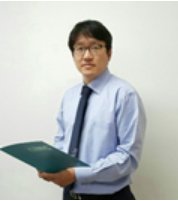
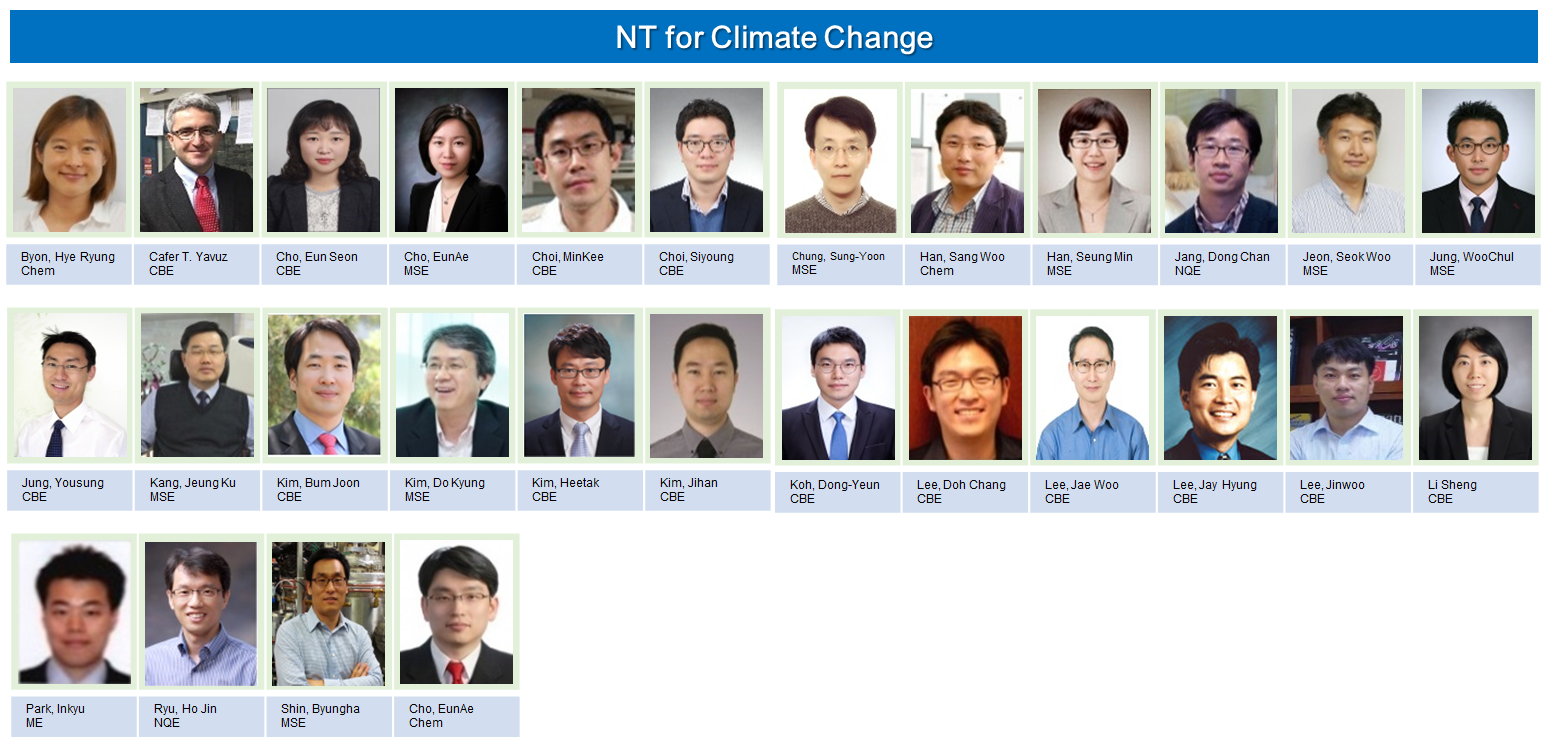
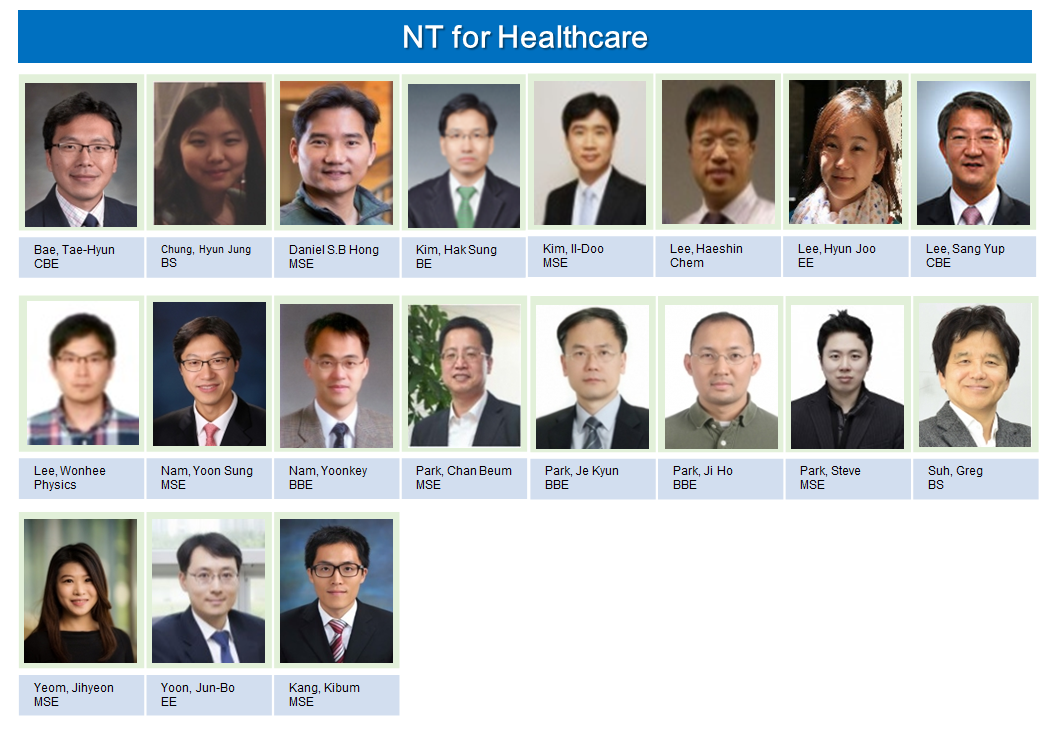
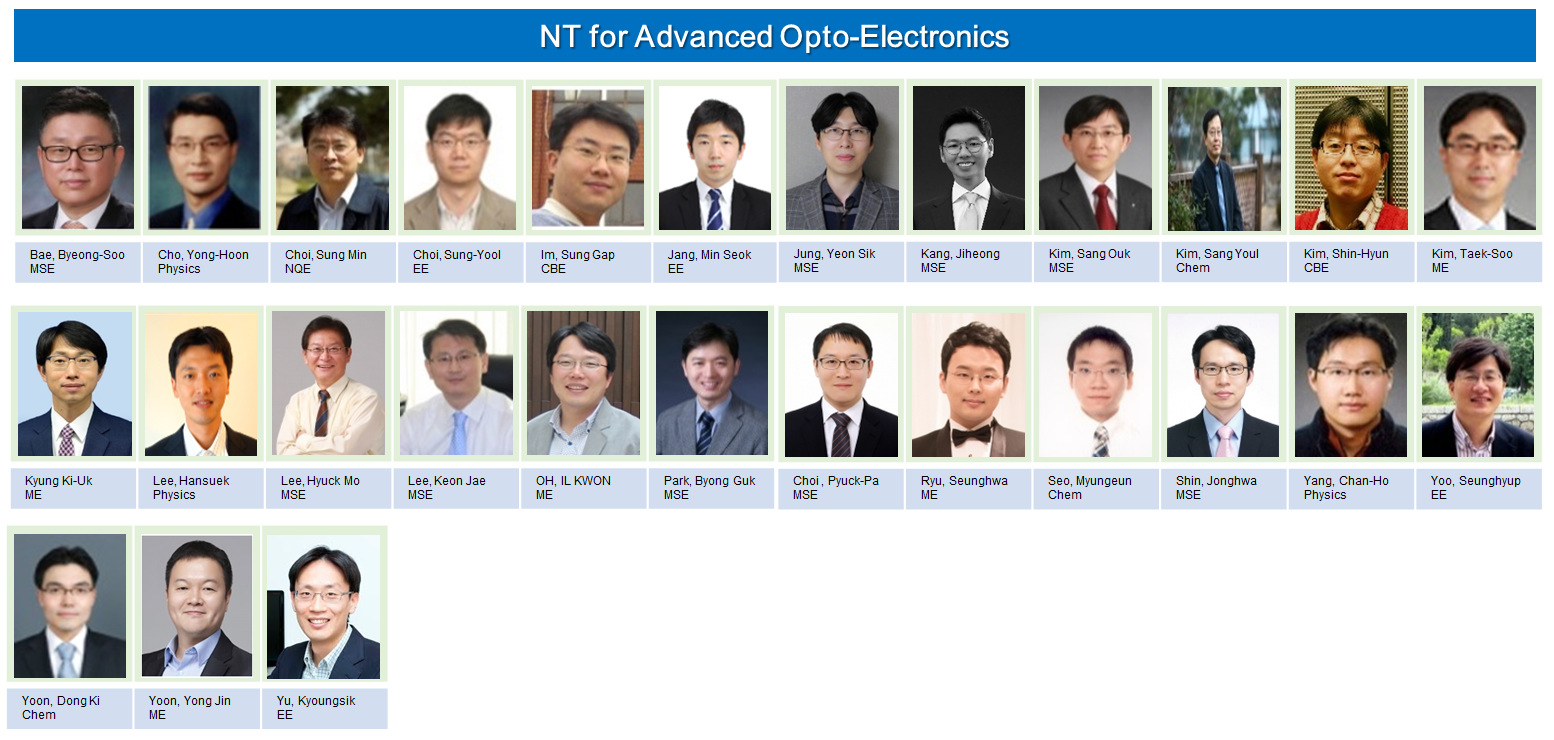
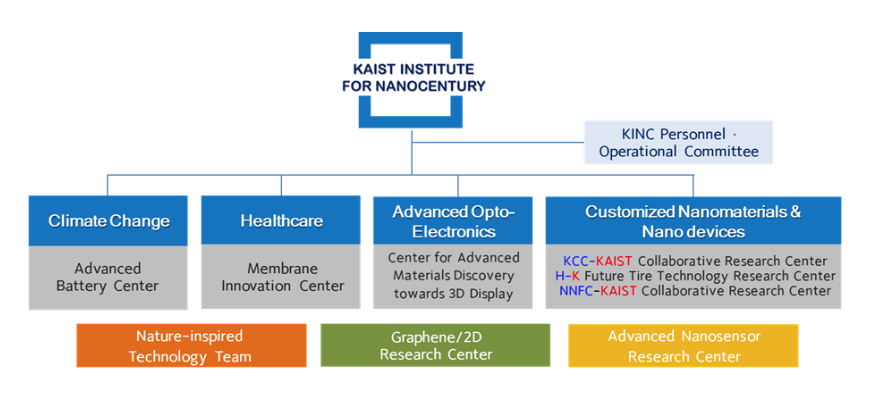
Advanced Battery Center
(Director: Prof. Hee-Tak Kim)





Advanced Battery Center
(Director: Prof. Hee-Tak Kim)
The Advanced Battery Center (ABC) at KINC, headed by Prof. Hee-Tak Kim, is one of the leading battery research centers in Korea. Founded in 2017 by KNIC, ABC brings together unique technologies from seven professors at different departments of KAIST including chemical engineering, material engineering, and chemistry, and stimulates substantial and far-reaching progress in battery research. At the same time, ABC explores new battery applications and new batteries for specific applications. The aim of ABC is to achieve high-performance batteries and to contribute to advancing battery technology in Korea. To make an essential contribution to establishing a clean energy society, ABC emphasizes both fundamental and engineering research.
ABC conducts the development of new battery concepts and the synthesis and investigation of battery materials, using cutting-edge analysis technologies, nanomaterial engineering, and higher-level simulations. The research activity of ABC can be divided into two topics: aqueous batteries and lithium battery development. The two projects are intimately linked, and progress in any one requires working with the others to advance the state-art of technology. With this in mind, we have combined the efforts of many professors from different departments under one roof. The collaborative fusion research motivated by ABC will pave new ways to achieve high performance batteries.
Because wind and solar power are not always available for immediate use, the energy from renewable resources needs to be stored. Large scale energy storage system (ESS) functions as an energy-reservoir for renewable energy. Lithium ion battery is now dominating ESS technology, however, it does not provide enough safety for MWh-scale energy storage system. Against the backdrop, ABC develops inflammable and cost effective aqueous secondary batteries utilizing zinc, vanadium, brome, and organic redox materials. The membrane, which plays key role in aqueous redox batteries, is one of the major research topics for the aqueous batteries. ABC has developed some cost-effective membrane solutions by exploiting hydrocarbon-based uniform mesoporous membranes and ultrathin LB based perfluorinated membranes. Very recently, ABC successfully demonstrated membraneless and flowless Zn-Br battery and extended the cycling life of Zn-Br battery by more than 10 times by achieving dendrite free Zn deposition with exploiting defective carbon chemistry.
Similarly, electric cars equip batteries for intermediate storage of the electrical energy and their cruise range is determined by the energy of battery stored. The current lithium ion battery technologies do not provide a means to extend the cruise range to a level equivalent to that of internal combustion engine-based cars due to their limited energy density. ABC’s ambitious challenge is to develop an ultra-high-energy-density lithium-sulfur and lithium-air chemistry. ABC invented a new electrolyte design for lithium-sulfur batteries; it features the use of a high donor number salt anion, and prevents electrode passivation by inducing 3D growth of Li2S. A composite protection layer, which induces uniform Li deposition and suppresses electrolyte decomposition is also under development to achieve long cycling stability of these lithium metal batteries.
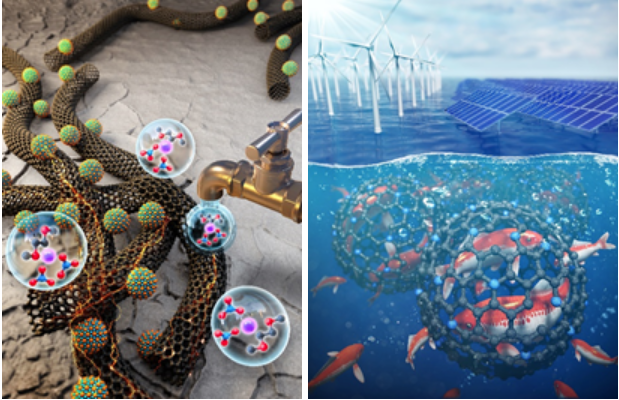
Membrane Innovation Center
(Director: Prof. Il-Doo Kim)
The Membrane Innovation Center for Anti-Virus & Air-Quality Control (MICA) was established in 2020 with a central research focus on the development of effective filters against airborne pollutants (e.g. particulate matter) and pathogens (e.g. the SARS-CoV-2 virus). On one hand, increased levels of particulate pollution have become a major threat to our respiratory health; on the other hand, the recent outbreak of Coronavirus Disease-19 (COVID-19) has led to a public health crisis. Filter membranes have played crucial roles in sieving out ultrafine particulate matter (PM1.0) with sizes around 1 µm. However, viruses such as SARS-CoV-2 are smaller than 100 nm and are carried by small droplets or aerosols. Thus, it is necessary to develop filter membranes with high filtration efficiency for adequate protection against the transmission of such viruses.
MICA consists of four KAIST professors—Prof. Il-Doo Kim (MSE), Prof. Seokwoo Jeon (MSE), Prof. Yoon Sung Nam (MSE), and Prof. Tae-Hyun Bae (CBE)—and their respective teams spearheading the efforts to develop anti-virus filter membranes. MICA seeks to develop novel material systems such as a physical filtration membranes based on nanofibers functionalized with antiviral and antibacterial agents, which retain their superior filtration efficiency while effectively sterilizing SARS-CoV-2 viruses. MICA has secured the technology for aligned electrospinning, nanoporosity control, and functionalization of antibacterial agents towards the development of effective anti-virus filters for applications in masks, protective suits, and air purification systems.
– Development of filters against the transmission of airborne pathogens, such as SARS-CoV-2, and their carriers (droplets/aerosols).
– Development of virucidal membranes by functionalizing with antiviral agents.
MICA strives to contribute to improve public health by combating not only COVID-19 but also the seasonal flu, utilizing anti-virus filter technologies developed by researchers here at KAIST together with scaled-up production and reduced cost.
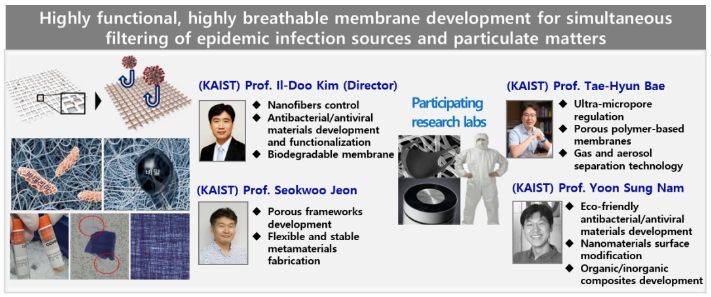
Center for Advanced Materials Discovery towards 3D Display
(Director: Prof. Sung-Yool Choi)
Next-generation displays are expected to show huge improvements over current devices. Because display technology relies heavily on core materials such as light-emitting materials, TFT channel/dielectric materials and electrodes, 10 professors and over 70 researchers/students in CAMD3 and KAIST have searching for novel high-performance materials. In particular, we have been developing molecular design and multiscale simulation methods to understand light-matter interaction, and various fabrication methods including phase separation of binary composites to discover innovative new materials, which will revolutionize the display technology and markets.
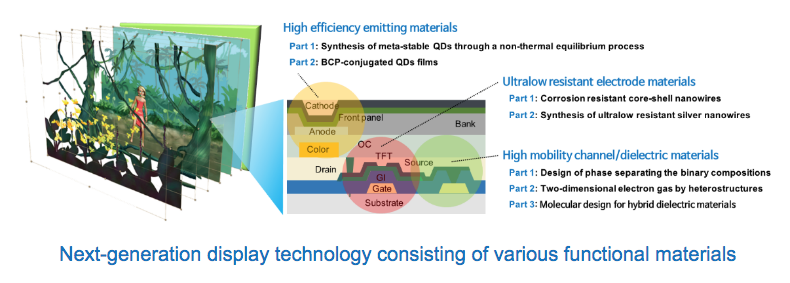
Based on our strong collaboration research, we accomplished a high light-emission efficiency (47%) of patterned quantum dot arrays, a high mobility TFT device (135 cm2/V·s) based on a vertical heterostructure of 2D materials, and an extremely low resistant electrode (sheet resistance 5 ohm/sq) through core-shell structured nanowires. Furthermore, we achieved ultra-resolution quantum dots LED (14,000 ppi) through a thermodynamic-driven polychromatic quantum dot patterning method.







